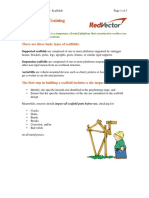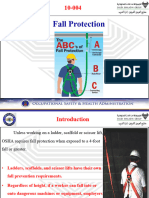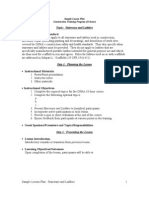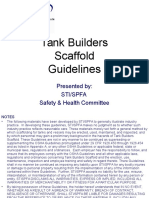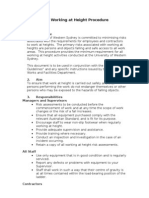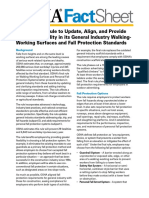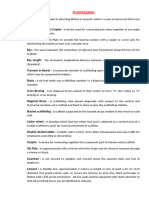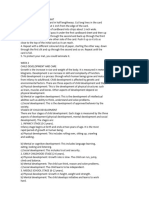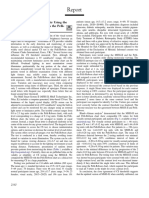Overview of OSHA Standard: Topic: Scaffolds
Overview of OSHA Standard: Topic: Scaffolds
Uploaded by
Hernan GamarraCopyright:
Available Formats
Overview of OSHA Standard: Topic: Scaffolds
Overview of OSHA Standard: Topic: Scaffolds
Uploaded by
Hernan GamarraOriginal Title
Copyright
Available Formats
Share this document
Did you find this document useful?
Is this content inappropriate?
Copyright:
Available Formats
Overview of OSHA Standard: Topic: Scaffolds
Overview of OSHA Standard: Topic: Scaffolds
Uploaded by
Hernan GamarraCopyright:
Available Formats
Sample Lesson Plan
Construction Training Program (10-hour)
Topic: Scaffolds
Overview of OSHA Standard
When OSHA revised its scaffolds standard in 1996, BLS studies showed that 25%
of workers injured in scaffold accidents had received no scaffold safety training, and 77%
of scaffolds were not equipped with guardrails. OSHA estimates that informed
employers and workers, in compliance with correct safety standards, can save as many as
50 lives and prevent 4,500 accidents every year. In a recent BLS study, 72 percent of
workers injured in scaffold accidents attributed the accident either to the planking or
support giving way, or to the employee slipping or being struck by a falling object.
The OSHA standard sets performance-based criteria to protect employees from
scaffold-related hazards such as falls, falling objects, structural instability, electrocution,
or overloading. It also addresses training and various types of scaffolds, as well as falling
object protection, ladders, weather conditions, aerial lifts, stilts, and other matters that are
not covered in OSHA’s previous scaffolding standards. In addition, it allows employers
more flexibility when using protective systems for workers on scaffolding.
Step 1: Planning the Lesson
• Instructional Materials.
1. PowerPoint presentation.
2. Instructor notes.
3. Other materials.
• Instructional Objectives.
1. Complete the required topics for the OSHA 10-hour course.
2. Complete the following optional topics:
a.
b.
c.
3. Present Scaffolds to [number] participants.
4. Incorporate active participation in each lesson.
5. Provide a quiz or short evaluation at the end of the course.
6. Ensure feedback from participants at various points in the training.
• Guest Speakers/Presenters and Topics/Responsibilities.
Step 2: Presenting the Lesson
• Lesson Introduction.
Introductory remarks or transition from previous lesson.
Sample Lesson Plan - Scaffolds 1
• Learning Objectives/Outcomes.
Upon completion of the lesson, participants will be able to:
1. Name the three types of scaffolds and describe their main characteristics.
Possible response.
• Supported scaffolds - platforms supported by rigid, load bearing members
such as poles, legs, frames and outriggers.
• Suspended scaffolds - platforms suspended by ropes or other non-rigid
means from an overhead structure.
• Aerial lifts - vehicle mounted devices used to get a worker to an elevated
position (e.g. cherry pickers or boom trucks).
2. List at least three of the four main hazards to which persons working on
scaffolds are exposed, and describe at least one method of hazard prevention
for each of the hazards.
Possible responses.
• Falls from elevation
Use guard rails
Use fall arrest systems
• Scaffold collapse or bad planking giving way
Ensure proper scaffold construction
Do not overload with people or equipment
Use personal fall arrest systems
Have a competent person check scaffold, as required
• Struck by falling tools or debris
Barricade the area below the scaffold and forbid entry
Use panels or screens
Build a canopy or net that will contain or deflect falling objects
• Electrocution
Honor clearance distances required between power lines and
scaffolding
De-energize the lines
Install protective covering
Sample Lesson Plan - Scaffolds 2
• Learning Objectives/Outcomes. (Continued)
3. Identify the three essential elements of safe scaffold construction, and give at
least three examples of incorporating each of the elements.
Possible responses.
• Use of appropriate scaffold construction methods
The height of the scaffold should not exceed four times its base
Ensure gaps between decking and work areas meet OSHA
requirements
Must be able to support is own weight plus four times the
maximum load
Proper overlap, fittings and restraints
Platforms supported by legs, outrigger beams, brackets, poles,
uprights, posts and frames
Suspension scaffolds supported by connecting hardware, and
suspension rope that can withstand six times its maximum load
• Proper scaffold access
Provide access when platforms are more than two feet above or
below access point
Use portable-type ladders, stair towers, ramps and walkways
Ladders may not have the bottom rung more than 24 inches high
May use building stairs and come out a window
May access from another scaffold, structure or hoist, but may not
use cross braces to gain access
• Ensuring proper incorporation of the role of a competent person
Scaffolds can only be erected, moved, dismantled or altered under
the supervision of a competent person
A competent person must inspect the scaffold for visible defects
before each shift and after any alterations are performed, and
defective parts must be replaced immediately
A competent person determines whether an appropriate means of
access is provided, based on site conditions
A competent person trains workers to recognize hazards
A competent person determines if it is safe to work on a scaffold
during storms, inclement weather (such as icing conditions), or
high winds
• Planned Activities, Discussion, or Participant Interaction
Step 3: Evaluating Student Learning and Instruction
• Lesson Evaluation and Comments.
.
Sample Lesson Plan - Scaffolds 3
References
OSHA Standard: 29 CFR 1926 Subpart L (1926.450 to 1926.454)
OSHA Publications
www.osha-slc.gov/OshDoc/Additional.html
• 3100 Crane or Derrick Suspended Personal Platforms
• 3150 A Guide to Scaffold Use in the Construction Industry
OSHA References/Resources
• Construction Safety and Health Outreach Program - Scaffolding
www.osha-slc.gov/doc/outreachtraining/htmlfiles/scaffreg.html
• Different Types of Scaffolds
www.osha-slc.gov/NewInit/Scaffolds/Handout.pdf
• OSHA Construction eCAT - Falls: Improper Scaffold Construction
www.osha.gov/SLTC/construction_ecat/falls/improper_scaffolds.html
• OSHA Construction Scaffolding eCAT
www.osha.gov/SLTC/scaffolding_ecat/index.html
• OSHA Technical Links - Construction: Scaffolding
www.osha.gov/SLTC/constructionscaffolding/index.html
• OSHA Technical Links - Scaffolding
www.osha.gov/SLTC/scaffolding/index.html
• Pump Jack/Ladder Jack Scaffold Photo Compliance Guide
www.osha.gov/SLTC/pptpresentations/pumpjack_0398/index.html
• Scaffolding Slides
www.osha.gov/SLTC/scaffolding/scaffold_slides/mainpage.html
• Scaffolds Outreach Memo (includes slides and handout on different types of
scaffolds)
www.osha.gov/NewInit/Scaffolds/index.html
• Video - A Basic Look At Scaffolds For Compliance Officers
www.osha.gov/SLTC/video/scaffold/video.html
• Working with Scaffolding - Using them Properly to Prevent Hazards. Job Safety
and Health Quarterly - Spring 1999
www.osha.gov/Publications/JSHQ/jshq-v10-3-spring1999.pdf
Sample Lesson Plan - Scaffolds 4
You might also like
- Fall Protection Orientation Refresher - FN000304Document68 pagesFall Protection Orientation Refresher - FN000304Predrag Andjelkovic100% (1)
- SOP ScaffoldingDocument7 pagesSOP ScaffoldingNakkolop100% (1)
- Application Form - EngineeringDocument6 pagesApplication Form - EngineeringZorka PanonkaNo ratings yet
- Basic Situation Analysis - ParathaDocument6 pagesBasic Situation Analysis - ParathaJemerlyn Erika0% (1)
- Split Case Pump MosDocument10 pagesSplit Case Pump MosFakhreddine Ezzahi100% (1)
- Scaffolding Safety TrainingDocument25 pagesScaffolding Safety Trainingmt_powers100% (1)
- Osha FS-3759 PDFDocument3 pagesOsha FS-3759 PDFabdul khaderNo ratings yet
- Jig JigDocument3 pagesJig JignsbNo ratings yet
- Scaffolding DocumentDocument8 pagesScaffolding Documenthussainmh6No ratings yet
- Osha3722 PDFDocument2 pagesOsha3722 PDFTharaka Perera100% (1)
- WAH Final PresentationDocument72 pagesWAH Final PresentationS RNo ratings yet
- 10 - 004 - Fall ProtectionDocument23 pages10 - 004 - Fall ProtectionUnique OfficerNo ratings yet
- COSH 413 2022 - Module 5 - Scaffolding Safety, DO 128 - 13 As Amended Rule 1414Document12 pagesCOSH 413 2022 - Module 5 - Scaffolding Safety, DO 128 - 13 As Amended Rule 1414Xandra Patricia BarreraNo ratings yet
- Construction Site Premises 2Document50 pagesConstruction Site Premises 2mcpayodNo ratings yet
- Scaffolds 3slidesDocument13 pagesScaffolds 3slidesCharles MitchellNo ratings yet
- Scaffolding 1Document2 pagesScaffolding 1Anica Pollyn Bumanglag VillanuevaNo ratings yet
- Stairs Ladders Lesson PlanDocument3 pagesStairs Ladders Lesson Planthongtn2007100% (1)
- ScaffoldDocument8 pagesScaffoldSAYED100% (1)
- Scaffold and ScaffoldingDocument15 pagesScaffold and ScaffoldingAbestano JadeNo ratings yet
- 19ISX13-Unit 3Document15 pages19ISX13-Unit 3Thayanithi ThayaNo ratings yet
- LESSON 2.2-Scaffold Safety RulesDocument3 pagesLESSON 2.2-Scaffold Safety RulesFelamae BaynosaNo ratings yet
- Fall ProtectionDocument4 pagesFall ProtectionnainaNo ratings yet
- OSHA WorkSafe ConstructionDocument36 pagesOSHA WorkSafe ConstructionLan Tian100% (1)
- Office of State Human ResourcesDocument8 pagesOffice of State Human ResourcesMOHAMEDNo ratings yet
- Tank Builders ScaffoldDocument40 pagesTank Builders ScaffoldEhab SaadNo ratings yet
- Scaffold LadderDocument134 pagesScaffold Ladderchaitanya_kumar_13No ratings yet
- Scaffolds: Anid Group Sarl ForDocument8 pagesScaffolds: Anid Group Sarl Forhamoody_007No ratings yet
- HSE Chapter 2Document42 pagesHSE Chapter 2bil3rab.desNo ratings yet
- Ladder Safety ProgramDocument6 pagesLadder Safety Programmirza ateeq baigNo ratings yet
- 28 - Scaffolding ProceduresDocument17 pages28 - Scaffolding ProceduresLalit Tomar100% (1)
- SOP For ScaffoldingDocument5 pagesSOP For ScaffoldingkannanNo ratings yet
- Working at HeightDocument62 pagesWorking at HeightAkshaIQ trainingandconsultancyNo ratings yet
- FPE - 1 - Working at Heights PDFDocument7 pagesFPE - 1 - Working at Heights PDFKaruppuswamy PalanisamyNo ratings yet
- Standard Operating Practice Use of Step LaddersDocument4 pagesStandard Operating Practice Use of Step Ladderstenor.daleNo ratings yet
- Fall Protection and Ladder SafetyDocument56 pagesFall Protection and Ladder SafetyKAii Magno GuiaNo ratings yet
- Supported Scaffolds: Requirements and Best PracticesDocument40 pagesSupported Scaffolds: Requirements and Best Practicesmohanprasad7781No ratings yet
- SSHO Module 6 - ScaffoldingDocument61 pagesSSHO Module 6 - ScaffoldingAnge Juan100% (1)
- Working at Height Rev 4Document71 pagesWorking at Height Rev 4Adrian Seng100% (3)
- Scaffolding SopDocument2 pagesScaffolding SopSumit SolankiNo ratings yet
- Etd Safety Topic Fall Protection 2018Document2 pagesEtd Safety Topic Fall Protection 2018drramesarNo ratings yet
- Working at Elevations Fact SheetDocument1 pageWorking at Elevations Fact SheetfaithablazebNo ratings yet
- UWSWorking Safely at Height ProcedureDocument5 pagesUWSWorking Safely at Height ProcedureRajanbabuNo ratings yet
- Fall Protection CDocument3 pagesFall Protection CkumhotriNo ratings yet
- John Burke - Safe Work at HeightDocument32 pagesJohn Burke - Safe Work at HeightRoman DuranNo ratings yet
- Osha3903 PDFDocument3 pagesOsha3903 PDFgetz_meNo ratings yet
- Fall Protection GRP 4Document9 pagesFall Protection GRP 4Ruben SibayanNo ratings yet
- Fall Protection: OSHA (Occupational Safety and Health Act of 1970)Document8 pagesFall Protection: OSHA (Occupational Safety and Health Act of 1970)Tristan Paul Guerra OrodioNo ratings yet
- OSHA Fall Protection Fact SheetDocument3 pagesOSHA Fall Protection Fact SheetGene DiJosephNo ratings yet
- Scaffold Work HandoutDocument2 pagesScaffold Work HandoutRija Hossain100% (1)
- ScaffoldingDocument12 pagesScaffoldingglobal.assistancegabonNo ratings yet
- Chapter 3: Fall Protection/ Scaffolding Safety: Learning ObjectivesDocument18 pagesChapter 3: Fall Protection/ Scaffolding Safety: Learning ObjectivessrdrNo ratings yet
- Working at Height FINALDocument57 pagesWorking at Height FINALInnocent BhaikwaNo ratings yet
- SOPDocument8 pagesSOPAilyn MercadoNo ratings yet
- Sheet: Reducing Falls in Construction: Safe Use of Extension LaddersDocument3 pagesSheet: Reducing Falls in Construction: Safe Use of Extension LaddersjefhdezNo ratings yet
- DIV14Document4 pagesDIV14Nathalie ReyesNo ratings yet
- Factsheet: Roof Tarping (Blue Roof) SafetyDocument2 pagesFactsheet: Roof Tarping (Blue Roof) SafetyIndermohan MehtaNo ratings yet
- 1868 Sop Work at HeightDocument10 pages1868 Sop Work at HeightAbid AzizNo ratings yet
- Fall ProtectionDocument17 pagesFall ProtectionCh Azeem AhmadNo ratings yet
- Fall Protection Program: University of Wisconsin-Platteville Reviewed 4/2016Document10 pagesFall Protection Program: University of Wisconsin-Platteville Reviewed 4/2016i.kamalNo ratings yet
- SCAFFOLDING - THE HANDBOOK FOR ESTIMATING and PRODUCT KNOWLEDGEFrom EverandSCAFFOLDING - THE HANDBOOK FOR ESTIMATING and PRODUCT KNOWLEDGENo ratings yet
- Fuchs Lubricants Company - CEPLATTYN KG HMF 2500 - R00000451017 - 05-29-2015 - English PDFDocument7 pagesFuchs Lubricants Company - CEPLATTYN KG HMF 2500 - R00000451017 - 05-29-2015 - English PDFgunduanil17No ratings yet
- Module 14, 15 & 16Document12 pagesModule 14, 15 & 16dorie shane sta. mariaNo ratings yet
- MOTIV ManagingShrimpHealth DR - HoaDocument35 pagesMOTIV ManagingShrimpHealth DR - HoakhanhsunjinNo ratings yet
- 2014 Investigating The Impact of Education and Contact-Based Anti Stigma Interventions On The Stigma of Mental Illness in The College PopulationDocument165 pages2014 Investigating The Impact of Education and Contact-Based Anti Stigma Interventions On The Stigma of Mental Illness in The College PopulationAneesha HamidNo ratings yet
- AntibioticsDocument4 pagesAntibioticsVladimir GurjanovNo ratings yet
- Policies Related To HivDocument20 pagesPolicies Related To HivGandimarei100% (1)
- Jurnal Plasenta Akreta PDFDocument5 pagesJurnal Plasenta Akreta PDFfatqur28No ratings yet
- Ayusante CatalogueDocument12 pagesAyusante CatalogueannamyemNo ratings yet
- Chapter FFFDocument44 pagesChapter FFFDominic DamascoNo ratings yet
- Basic Pest & Disease Control For OrchidsDocument4 pagesBasic Pest & Disease Control For OrchidsAnonymous HXLczq3No ratings yet
- Week 1-9 jss3 HOME ECCONOMICSDocument8 pagesWeek 1-9 jss3 HOME ECCONOMICSopeyemiquad123No ratings yet
- Measuring Contrast Sensitivity Using The M&S Smart System II Versus The Pelli-Robson ChartDocument3 pagesMeasuring Contrast Sensitivity Using The M&S Smart System II Versus The Pelli-Robson ChartRaissaNo ratings yet
- CT Ws Somatom Definition Flash International-00292513 PDFDocument44 pagesCT Ws Somatom Definition Flash International-00292513 PDFAsep Nur HidayatNo ratings yet
- Topic 3 (Employee Well-Being, Mental Heath, and Work-Related StressDocument4 pagesTopic 3 (Employee Well-Being, Mental Heath, and Work-Related StresswatarasigeNo ratings yet
- Application For Medicare Savings Programs (QMB, SLMB, ALMB) : State of Connecticut Department of Social ServicesDocument6 pagesApplication For Medicare Savings Programs (QMB, SLMB, ALMB) : State of Connecticut Department of Social ServicesMohammad HamidNo ratings yet
- Cefic PG Usp GuidelinesDocument46 pagesCefic PG Usp GuidelinesChanduSaiHemanthNo ratings yet
- Learning Activity SheetDocument4 pagesLearning Activity SheetUnard Jv CasimeroNo ratings yet
- PRINT - 08.P5321 - 2008 Capstone - InddDocument47 pagesPRINT - 08.P5321 - 2008 Capstone - InddSarah ArmstrongNo ratings yet
- Thesis QualiDocument17 pagesThesis QualiAcademic ServicesNo ratings yet
- Harga Dan Generik Update Februari 2017 FixDocument4 pagesHarga Dan Generik Update Februari 2017 Fixangga kharismaajiNo ratings yet
- Memo ProjectDocument20 pagesMemo Projectgungunverma4173No ratings yet
- Child Abuse SpeechDocument4 pagesChild Abuse SpeechKatelin Lucine100% (4)
- Kasetsart Journal of Social Sciences: Ekarin Phungpracha, Kulvadee Kansuntisukmongkon, Opart PanyaDocument6 pagesKasetsart Journal of Social Sciences: Ekarin Phungpracha, Kulvadee Kansuntisukmongkon, Opart PanyaIwan SetiawanNo ratings yet
- In Vitro Evaluation of The Fracture Resistence and MicroleakageDocument8 pagesIn Vitro Evaluation of The Fracture Resistence and MicroleakageRommy MelgarejoNo ratings yet
- Neonatal JaundiceDocument4 pagesNeonatal JaundiceChristian Eduard de DiosNo ratings yet
- CHUYÊN ĐỀ - TỪ TRÁI NGHĨA GVDocument9 pagesCHUYÊN ĐỀ - TỪ TRÁI NGHĨA GVanhgaygo1234No ratings yet
- Narrative Pictorial On Virtual Lac Session Mental Health AwarenessDocument3 pagesNarrative Pictorial On Virtual Lac Session Mental Health Awarenessydieh donaNo ratings yet








